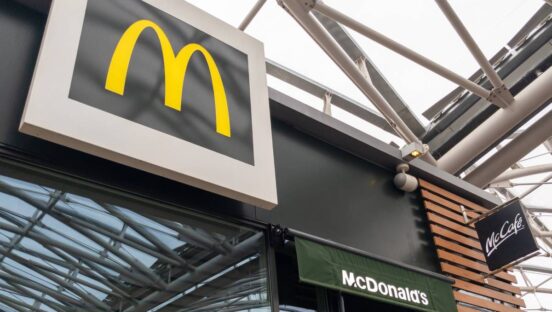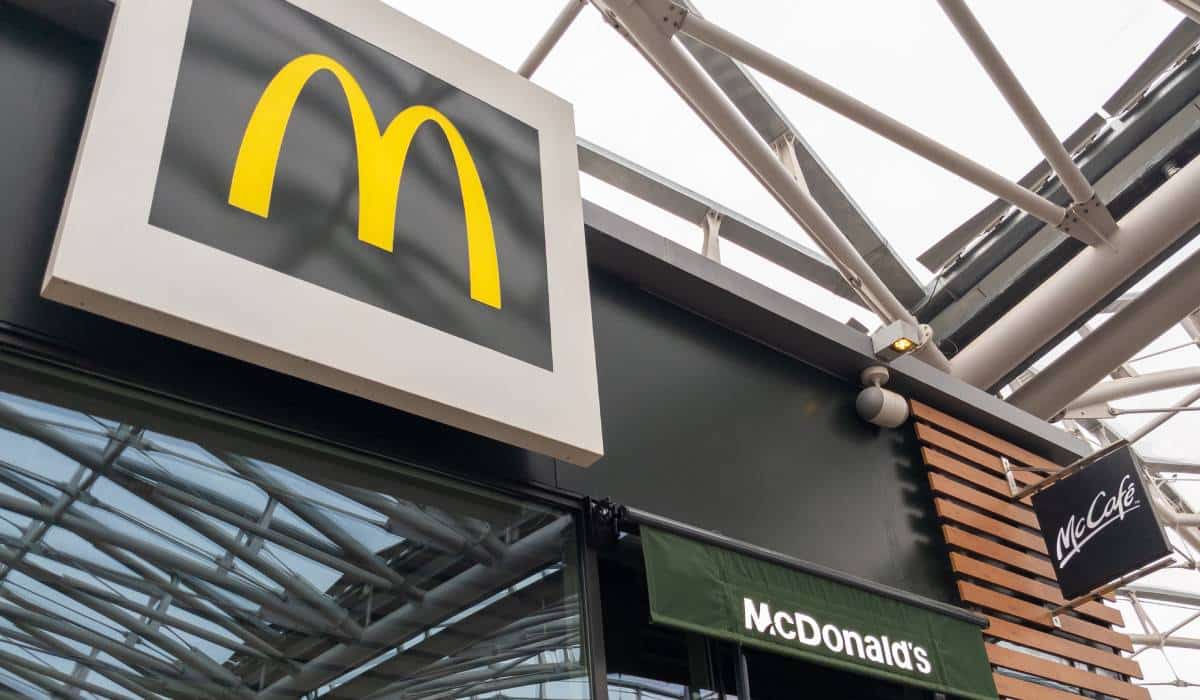McDonald’s has experienced comparable sales growth of more than 30 percent since 2019. Its business—like the breadth of the industry—adjusted widely to COVID-19 and the digital floodgates that opened. The brand’s first U.S. loyalty program (it had platforms in other countries, like France) arrived July 2021. In just two years, McDonald’s systemwide sales to loyalty users reached $20 billion. It was more than $6 billion in Q4 alone through 50 markets, with full-year growth north of 45 percent over 2022.
The battle for market share rolled into new arenas. McDonald’s same-store sales increased 4.3 percent in Q4, a result driven by average check expansion with pricing in the high-single digits—implying traffic was negative low-to-mid single digits.
McDonald’s ability to grow its top-line despite tepid guest counts isn’t novel or an outlier; it’s been the reality across foodservice through inflation for months now, especially in fast food.
Per Revenue Management Solutions, Q4 traffic in quick service fell 1.7 percent versus the prior year. Average price hiked 4.5 percent, although it has been decelerating. Quick-service traffic trends are down nearly 20 percent from 2019.

Net sales were 2.5 percent higher, year-over-year, as average check lifted 4.3 percent across the sector. Quantity per transaction slipped 0.3 percent and has remained negative throughout 2023 and 2022, suggesting this might be the “new normal” coming out of those pandemic occasions when guests stocked up during visits.



All this brings us to a question McDonald’s CEO Chris Kempczinski faced Monday on the chain’s Q4 earnings: Where does this jostle for share head next? “… the battleground is certainly with that low-income consumer,” Kempczinski said
As the company has shared in recent reviews, McDonald’s witnessed U.S. pressure with that familiar cohort, which Kempczinski defined at $45,000 and under. This isn’t all that stunning, really, given grocery and supermarket prices have declined for 16 straight months. The food-at-home (grocery store or supermarket food purchases) consumer price index decreased 0.1 percent from November to December and was 1.3 percent higher than December 2022.
MORE: McDonald’s Feels Global Impact from Israel and Palestine War
Food-away-from-home (restaurant purchases), meanwhile, lifted 0.3 percent in December 2023 and was 5.2 percent above December 2022. Akin to what RMS noted, menu prices are leveling out—that December figure was the lowest since September 2021. Yet it’s still outstripping overall inflation (3.9 percent) and, more notably in this case, forming a not-insignificant divide between what it costs to dine at home and the price of a restaurant meal. The early months of 2024 are busting the sentiment “grocery stores are just as expensive as restaurants these days.”
“There’s been much less pricing that’s been taken more recently on packaged food,” Kempczinski said. “So you’re seeing that eating at home is becoming more affordable. That, I think, is putting some pressure … on that low-income consumer.”
It’s also accurate McDonald’s benefitted from the top of this dynamic cascading down. Higher-income consumers are trading out of other categories and the same is true of middle-income. Eventually, it brings diners into McDonald’s who might not have been there when pricing wasn’t so sensitive. “We continue to gain share with those groups,” Kempczinski said.
Naturally, while the influx of higher- and middle-income customers has been a welcome revenue driver for McDonald’s, the chain is going to court value-seekers atop a fast-food category that built its history and frequency on affordability. “Think about that as being absolute price point being probably more important for that consumer in a lower absolute price point to get them into the restaurants than maybe a value message, which is a two for $6 or something like that,” Kempczinski said of “affordability.”
“Those probably are going to resonate a little bit less in 2024. Particularly, we think in the front half with the consumer, there may be something that’s lower absolute price points.”
“We are set up well to be able to go after that,” he added, mentioning McDonald’s $1 $2 $3 platform. Kempczinski said activity will pick up there in the U.S. at the local level “to make sure we continue to provide good value for that low-income consumer.”
BTIG analyst Peter Saleh wrote in a note Tuesday he expects more aggressive price-point advertising in the coming year to lure this group back. “We think this is made possible by moderating commodity inflation, expected to be in the low-single digits this year,” he said.
Some examples have taken shape in other markets of late. Canada, for instance, maintained its McMuffin and hot coffee pairing in Q4, providing an affordable bundle “during a critical daypart and helping to drive market share gains in breakfast,” CFO Ian Borden said. The U.K. followed a similar playbook by expanding “Saver Meal” deals—only available in-app—to offer smaller bundles in the morning. In Australia, McDonald’s resurfaced a 30-days, 30-deals promotion for digital users. Borden said that “drove remarkable engagement and contributed to a record number of active loyalty members in the market.”
Canada also offered Monopoly with a double-peel option for the first time (meaning customers had a second chance to win in the app). The market hit water-mark results and generated nearly 700,000 new app customers in five weeks. More than 43 million Monopoly codes were digitally redeemed during the promotion. That’s more than the entire population of Canada (38.25 million). Germany and France featured Monopoly, too, with the former appreciating record-breaking registrations as it offered loyalty points as prizes for the first time.
Overall pricing for the year at McDonald’s (it varies by market) was about 10 percent. Borden said it came down in Q4 in line with inflation to high single-digits. “We’re continuing to see pretty consistent flow through with pricing, which I think is really important because it goes back to what I’ve spoken about before with just the tools and capabilities that we’ve put in place to make sure that when we are taking pricing, we’re doing that in the most effective way possible,” he said.
In other terms, as McDonald’s navigates 2024, knowing inflation has declined a good bit from its peak, pricing should slow roughly in line. Kempczinski said U.S. franchise cash flows were up roughly $35,000 last year, despite the price headwinds.
“We certainly know consumers are more weary or weary of pricing, and we’re going to continue to be consumer-led in our pricing decisions as we forward to 2024 and knowing that the environment will continue to be competitive,” Borden said. “We’ll be thoughtful together with our franchisees, obviously, who make those decisions in their own restaurants as we look forward.”
One place menu price is unlikely to temper is California, as AB 1228 introduces a $20 wage floor for workers at quick-service chains with at least 60 locations. It goes into effect April 1.
Currently, minimum wage in California is $15.50. The National Owners Association, which consists of 1,000-plus McDonalds owners, stated in a memo the shift would cost California locations some $250,000 annually.
McDonald’s didn’t address the topic much Monday, with Borden telling investors wage inflation would “probably” run in the mid- to higher-single-digit range this year. Part of that, he added, was due to what’s about to unfurl in California.
Management projected U.S. same-store sales to be 3–4 percent this year, which suggests flat traffic at best. Saleh gave McDonald’s stock a neutral rating Tuesday in response to these developments and broader forces. “The company was able to generate several years of outsized sales growth in the U.S. and most major markets amid the recovery from COVID disruption owing to relevant menu offerings, restaurant upgrades, digital engagement, and stronger leadership,” Saleh said. “While these efforts have created a significant competitive advantage for McDonald’s in many markets around the world, more normalized sales trends, pressure on the lower-income consumer, and the Middle East conflict are resulting in more limited sales gains going forward. Given the moderating traffic, more normalized sales trends and lower earnings growth, we see less opportunity for earnings upside and an above-historical average multiple …”
McDonald’s loyalty user base—circling back to channel growth—boasted 150 million active users in the last 90 days, “making us one of the largest loyally programs in the world,” Kempczinski said. The goal is to reach 250 million active users and $45 billion in annual loyalty systemwide sales by the end of 2027.
In McDonald’s three-year, 30 percent comps run, Kempczinski added McDonald’s delivered sales by developing the McCrispy chicken sandwich globally. It was originally tested in a few markets to solve an unmet customer need. From 2010 to 2023, according to the U.S. Department of Agriculture, annual consumption of chicken in the U.S. increased from 82.8 average pounds per capital to 101.7 (projection; it was 100.6 in 2022). Beef declined in that same window from 59.3 to 57.9.
And so, unsurprisingly, McDonald’s scaled quickly and McCrispy today is a $1 billion brand across over 30 markets worldwide. The chain’s chicken category now represents $25 billion in annual systemwide sales—on par with beef.
Kempczinski teased McDonald’s sees potential in adding another point of chicken share by 2026, “in part through an expansion of our McCripsy platform into wraps and tenders.”
About a year ago, McDonald’s also formed a new business ventures team designed to operate as an entrepreneurial startup within McDonald’s. That’s where CosMc’s came from. “… the buzz has been electric,” Kempczinski said.
Additionally, McDonald’s implemented “Accelerating the Organization,” an effort to modernize the company’s workflow and remove layers better corporate and restaurants. The business unit lives out of the company’s Denver field office and focuses on digital, frequency, and engagement opportunities. One example being “Ready on Arrival.” Nationally, it’s a system that’s reduced wait times for curbside pickup by 60 seconds. Crew get information to the right person in the restaurant to deliver food faster. That will expand across McDonald’s top six markets by the end of 2025.









